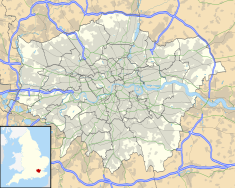
Back Westminster-abdy Afrikaans Westminster Abbey ALS دير وستمنستر Arabic دير ويستمينستر ARZ Abadía de Westminster AST Vestminster abbatlığı Azerbaijani وست مینیستر کیلیساسی AZB Вестминстер аббатлығы Bashkir Вэстмінстэрскае абацтва Byelorussian Ўэстмінстэрскае абацтва BE-X-OLD
| Westminster Abbey | |
|---|---|
 The Abbey's western façade | |
| Location | Westminster, London, England |
| Coordinates | 51°29′58″N 00°07′39″W / 51.49944°N 0.12750°W |
| Built | 10th century[1] |
| Architectural style(s) | Gothic |
| Official name: Westminster Palace, Westminster Abbey and Saint Margaret's Church | |
| Type | Cultural |
| Criteria | i, ii, iv |
| Designated | 1987 (11th session) |
| Reference no. | 426 |
| Country | United Kingdom |
| Region | Europe and North America |
Listed Building – Grade I | |
| Official name: Westminster Abbey (The Collegiate Church of St Peter) | |
| Designated | 24 Feb 1958 |
| Reference no. | 1291494[2] |

Westminster Abbey is a large and famous Anglican church in Westminster, London. It is the shrine of Edward the Confessor and the burial place of many kings and queens. Since it was built it has been the place where the coronations of Kings and Queens of England have been held. The present structure dates from 1245, when it was started by Henry III.
The status of the Abbey is that of a Royal Peculiar. This means it is place of worship that falls directly under the jurisdiction of the British monarch, rather than under a bishop. The concept dates from Anglo-Saxon times, when a church could ally itself with the monarch and therefore not be subject to the bishop of the area. Technically speaking, it is not a cathedral, though it is regarded as one in practice.
One of the most famous tombs at Westminster Abbey is that of the Unknown Warrior.
Westminster Abbey and its small parish church, St Margaret's, form a UNESCO World Heritage site, which also includes Westminster Palace.[3]
- ↑ Newcomb, Rexford (1997). "Abbey". In Johnston, Bernard (ed.). Collier's Encyclopedia. Vol. I A to Ameland (First ed.). New York, NY: P.F. Collier. pp. 8–11.
- ↑ "The National Heritage List For England". English Heritage. Archived from the original on 2012-05-01. Retrieved 2011-07-31.
- ↑ UNESCO, "Westminster Palace, Westminster Abbey and Saint Margaret's Church"; retrieved 2012-4-19.
